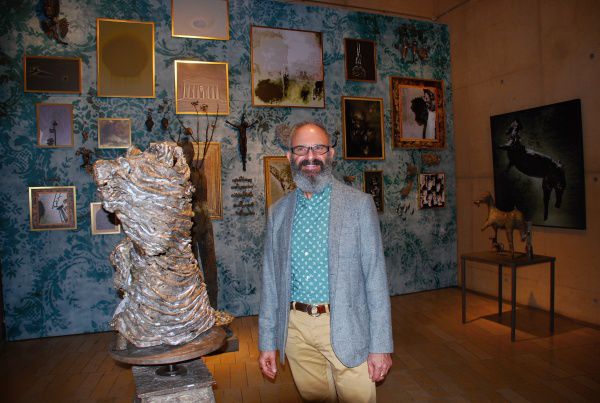As he walked through his current solo exhibition “Simon Toparovsky: Vessels and Channels” at the Cathedral of Our Lady of the Angels, artist Simon Toparovsky was inspired to do a bit of rock pile rearranging in one of the three side chapels that hold his art installations.
Climbing into the exhibition space, Toparovsky gracefully maneuvered past his image of Prometheus, the mortal who stole fire from the gods and was punished by being chained to a rock for eternity and having his liver eaten out every day by an eagle.
“A sacrifice for the good of humanity is a story that happens in every culture,” explains Toparovsky, whose artwork celebrates the breadth of the human condition — the difficult, the painful, the sublime and the wondrous.
After he was satisfied with the rock pile configuration, Toparovsky exited the exhibition space and pointed out that his Prometheus has the legs of a raptor. “Think about it,” he challenged. “If you are having your liver eaten out every day, you would need to embrace your enemy in order to survive.”
That spiritual imagery and more fuels the current exhibition of complex mixed-media, sculpture, photography and digital imaging that spans three unique-shaped spaces in the cathedral. The theme draws upon ancient stories, mythology, historical references and contemporary narratives to convey the depths of the human experience and its transcendent connections.
Toparovsky, an internationally acclaimed artist, is no stranger to the cathedral — he designed and created the life-size bronze crucifix that adorns the altar, a beloved image for visitors and parishioners.
At first blush, it may seem ironic that Toparovsky, who considers himself an observant, if non-practicing Jew, was selected to design the crucifix (his first liturgical commission). But his artistic recognition and sensitivity to spiritual aspects made him the perfect artist to create Christ on the cross, an experience that he recalled was “overwhelming, magical, wonderful and exhausting.”
“With that commission, came a great responsibility,” he said. “Once that was installed, it never felt like it belonged to me anymore. I mean, how could it? It’s not the same. It’s invested with the energy of the world. It’s now an icon for so many.”
Indeed, Toparovsky is often approached and thanked for his work when he is at the cathedral. “They will come up and throw their arms around me, wanting pictures and kissing me and looking so delighted,” he said. “But it’s not me, it’s not who I am that they are responding to. I am just a conduit. A conduit for courage and the vulnerable.”
For this current exhibition, Toparovsky created unique spaces for cathedral-goers to meditate on, consider and ponder. In this first chapel (located at the end of the cathedral’s main entrance), you will find a high, hedge-like structure with leaping creatures popping out of it. Peer into a small window and see a garden of bronze plant life, a shimmering light and … a mysterious elevator door.
A secret garden? A metaphor for life’s barriers? The journey between earth and heaven? All of the above and more, said Toparovsky.
Turn the corner and discover the second art room that Toparovsky refers to as a lararium, the ancient Roman custom of creating a sacred place near the front door where offerings and prayers could be made. Here works of art on paper and sculpture fill up a vibrant blue lacy wall with other artwork — evoking modern and ancient sensibilities — positioned throughout for spiritual speculation.
The bronze torso may seem familiar — it’s St. Sebastian, an early church martyr who is often depicted leaning against a tree, dying from multiple arrows shot into his body. In this instance, St. Sebastian’s body is also melding into the tree to signify his connection to Christ on the cross.
“I wanted to portray him with as much beauty and dignity I could imagine,” says Toparvosky about the saint who did not die from the arrows, but who was ultimately beaten to death.
“I wanted this exhibition to celebrate the breadth of the human condition,” sums up Toparovsky. “To be able to accept that things in life are hard and still carry on. That there are sacrifices to make in order to get that the place where things are wonderful — and to have that personal connection to the sublime.”
--------
"Vessels and Channels” is now on exhbit through Feb. 15 at the Cathedral of Our Lady of the Angels, 555 W Temple St., Los Angeles. A digital mosaic journal, “Imagining Christ: Making the Crucifix” is also on display in the cathedral basement.

